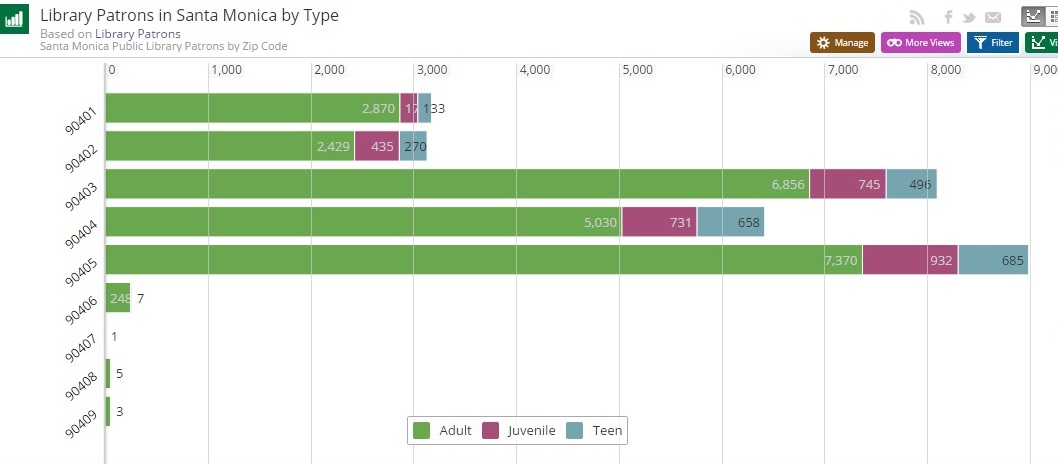How many times were the police called to your neighborhood last month? How much does the City charge for a construction permit? Where are Santa Monica’s free CityWiFi hotspots? How much do your public officials make? Which streets have bike sharrows and which have dedicated bike lanes?
These are just some of the few questions you can find answers to at data.smgov.net, the City’s new Open Data Portal, which had its soft launch late last month.
An Interactive Platform
The Open Data Portal acts as a one-stop-shop for all the information collected by the City. But it is also about much more than just having a place to look at spreadsheets and numbers online, City officials said. It’s about opening up City Hall to the people in a way that has only recently become possible with new technological developments.
Currently, the data sets are broken down into six categories on the Portal: Finance, Permits & Licenses, Public Assets, Public Safety, Public Services, and Transportation.
“Playing” with the Data

The Open Data Portal does more than just make more accessible the information that, in the days before the Internet, would be regulated to dusty ledgers in City Hall. It also gives users a chance to organize the information in ways that are convenient and comprehensible to themselves and others.
“We’ll actually do the leg work and the visualizations ahead of time,” said Abadi. For example, there is a map of Santa Monica’s 33,800 street trees that officials created using the data available on the Portal.
But the point of the Open Data Portal is about empowering people to use – and organize – the data themselves in the way that is most useful them, Abadi said.
Jory Wolf, the City’s Chief Information Officer, agrees.
“It’s about transparency and it’s about citizen engagement,” Wolf said about the new Open Data Portal.
To that ends, the Portal includes tools that let visitors create visualizations of the data sets, filter information, and save their work for others to see.
The Portal also includes a “full-fledged application programming interface [API],” Abadi said, which allows app developers to plug into the system for use in mobile device apps.
Perhaps the most visible example of that is ParkMe, a local Santa Monica tech startup that developed an app by the same name that uses real-time data gathered from the City to help visitors find out about parking availability and rates.
More to Come
As the number of data sets on the Open Portal grows, so too do the possibilities for third-party app developers who want to find new ways to deliver relevant information to the people.
“We’re not done with the loading of data,” said Wolf. “We’re now working with the departments and identifying other sets of data.”
Among the upcoming datasets are included Big Blue Bus real-time arrival information, street sign and curb designation information for the entire city, and fire department calls-for-service. Users can also suggest datasets that they would like to see made available. For example, we suggested a dataset that could be used to map all the bike parking around the city.
“This information is public information,” Wolf said. “We don’t want the public to think that anything is being hidden.”
What’s more, the Portal will be continually updated as datasets change. “Our datasets are constantly being fed,” said Abedi.
The Trend Toward Transparency
Santa Monica’s Open Data Portal is only the most recent in a growing trend among municipal governments.
Los Angeles, for example, launched its Open Data Portal at the end of May. DataLA has many of the same features as Santa Monica’s portal, but there are other data that Santa Monica doesn’t yet available.
Under the section called “A Liveable and Sustainable City,” DataLA has datasets that breakdown air quality measurements, water use, and even annual CO2 emissions generated by Los Angeles Department of Water and Power.
Open Data Portals have also begun opening public information to the people in new ways on the county, state, and national levels.
Technology and Civic Engagement in Santa Monica
While Santa Monica’s Open Data Portal may be new, the City’s commitment to transparency and engagement isn’t, Wolf said.
“Santa Monica has always seen itself as a pioneer in using technology, especially online technology, for citizen engagement,” he said.
In 1989, Santa Monica launched one of the first City-run public Internet forums in the country. Called the Public Electronic Network (PEN), the forum functioned primarily as a message board where participants discussed issues publicly and the City would publicize public events.
“[Santa Monica was] among the first cities in the nation to provide email to their City Council members,” said Wolf. Santa Monica was also on the cutting edge of providing live video streaming of public meetings as well as archiving video and audio files of those meetings online.
Recently, Santa Monica has had huge success with its GO system app, which allows users to report issues – damaged trees, graffiti, pot holes – directly to the relevant City department from their mobile devices.
And then, there are the City’s Know Before You Go and Be Excited! Be Prepared! initiatives, designed to help visitors and residents alike navigate Santa Monica with up-to-date information, readily available online, about street closures and construction delays.
For Wolf and Abadi, the City’s new Open Data Portal is just the latest development in a long history of technological innovation opening the doors to greater civic engagement.
